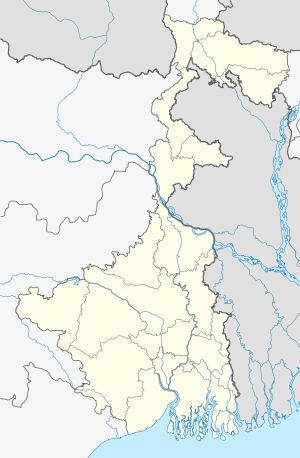Pandu Rajar Dhibi
| পাণ্ডু রাজার ঢিপি | |
 Shown within West Bengal | |
| Location | West Bengal, India |
|---|---|
| Coordinates | 23°34′19″N 87°38′59″E / 23.57194°N 87.64972°ECoordinates: 23°34′19″N 87°38′59″E / 23.57194°N 87.64972°E |
| Type | Settlement |
| History | |
| Founded | 750 BC or earlier |
| Periods | Chalcolithic period |
Pandu Rajar Dhibi (Bengali: পাণ্ডু রাজার ঢিপি) is an archaeological site in Ausgram block in the Sadar North subdivision of Bardhaman district in the Indian state of West Bengal. It was the first Chalcolithic site discovered in West Bengal. The main mound at Pandu Rajar Dhibi is associated with King Pandu mentioned in Mahabharata.[1][2]
Location
It is located near the southern bank of Ajay River and excavations have been made near Rajpotdanga and Panduk villages.[1][2]
Excavations
The site was first excavated by B.B. Lal in 1954-57.[2] While Pandu Rajar Dhibi was the first Chalcolithic or Copper Age site to be discovered, a number of other sites have been discovered in an area spread over the districts of Birbhum, Bardhaman, Bankura and Midnapore, and interspersed by rivers Brahmani, Mayurakshi, Kopai, Ajay, Kunur, Damodar, Dwarakesvar, Shilabati, and Rupnarayan.[2]
There were two main periods – the Chalcolithic period around 1600 BC – 750 BC, and the Iron Age.[2]
Significance
The excavations at Pandu Raiar Dhibi reveal the non-Aryan origin of the majority of non-Brahmin Bengalis. The Copper Age civilisation in eastern India had links with similar civilisation of central India and Rajasthan. In those days the people were capable of building well planned towns with pavements and streets. Agriculture and trade were the mainstays of their economy. It has been suggested that Pandu Rajar Dhibi represents the ruins of a trading township. The people carried out trade not only with interior parts of India but also distant lands such as Crete and the Mediterranean lands. They were predominantly a seafaring people.[3]
Limitations
The archaeological discoveries at Pandu Rajar Dhibi and the surrounding areas have not yet been properly studied by experts and as such the historical value must be regarded as uncertain.[3]
References
- 1 2 Chattopadhyay, Akkori, Bardhaman Jelar Itihas O Lok Sanskriti (History and Folklore of Bardhaman District.), (Bengali), Vol I, pp. 125-130, Radical Impression. ISBN 81-85459-36-3
- 1 2 3 4 5 Mukherjee, Shyam Chand (2012). "Pandu Rajar Dhibi". In Islam, Sirajul; Jamal, Ahmed A. Banglapedia: National Encyclopedia of Bangladesh (Second ed.). Asiatic Society of Bangladesh.
- 1 2 Majumdar, R.C., History of Ancient Bengal, 2005 edition, pp. 20-22
